Jan 21, 2012
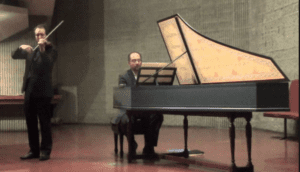
Telemann Sonatas for Violin & Harpsichord

Whaling City Sound Website
Websites: Paul Cienniwa, Dorian Bandy
Facebook, Twitter
YouTube
Bio
Itinerary
Press Release
Publicity: The Diapason, The Tannhauser Gate,Strings Magazine, The Whole Note, Audiophile Audition, The Huffington Post
Radio: WFMT
Previous Whaling City Sound Releases by Paul Cienniwa
Johann Sebastian Bach/Sonatas for Viola da Gamba (WCS046)
Harpsichord Music For A Thin Place (WCS059)
Mixed Media Client since: 1999
back to client list

Telemann: Violin Sonatas
Dorian Komanoff Bandy; Paul Cienniwa, hpsi
Whaling City Sound 108—80 minutes
This is the second recording I have encountered of Telemann’s unusual 1715 publication of sonatas for violin and harpsichord. The first was made by Valerio Losito and Federico Del Sordo and released by Brilliant (S/O 2017).
These are stylistically interesting works, marked by Telemann’s immersion in French styles. The performances here are alert and stylist, just a bit broader than the processors. For all that, this new recording makes space to add to the 1715 set a sonata that survives only in manuscript, marked by some stylistic foibles.
Romanoff Bandy uses a vibratoless technique that has its piercing moments, but his playing is certainly expert. It is also favored over the harpsichord in the balances.
The booklet notes by Bandy comment extensively on the styles and compositional techniques in these sonatas.
Both recordings have their merits, but I prefer this new one.
John W. Barker

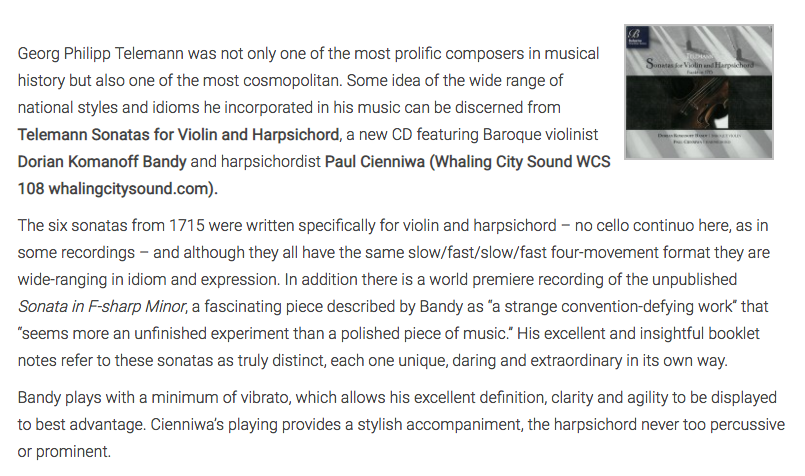
For October 26, 2018 Release
Classical
Telemann Sonatas for Violin & Harpsichord (WCS108)
Dorian Komanoff Bandy, Paul Cienniwa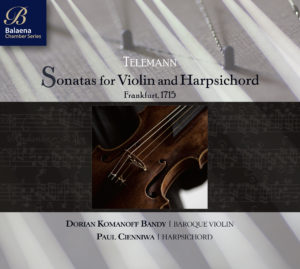
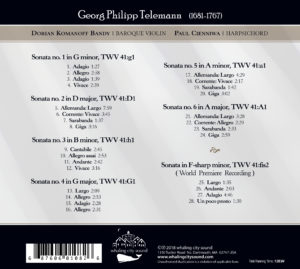
(Note that the “Frankfurt, 1715” is the “opus number” of this sonata set, so it’s part of the title, but it doesn’t need to be as big as the rest, or on the same line. I’d suggest formatting it something like what I’ve done above.)
Artists:
Dorian Komanoff Bandy, baroque violin
Paul Cienniwa, harpsichord
Composer:
Georg Philipp Telemann (1681-1767)
Track Listing:
Tracks 1-24: Six Sonatas for Violin and Harpsichord (Frankfurt, 1715)
Sonata no. 1 in G minor, TWV 41:g1
- Adagio
- Allegro
- Adagio
- Vivace
Sonata no. 2 in D major, TWV 41:D1
- Allemanda: Largo
- Corrente: Vivace
- Sarabanda
- Giga
Sonata no. 3 in B minor, TWV 41:h1
- Cantabile
- Allegro assai
- Andante
- Vivace
Sonata no. 4 in G major, TWV 41:G1
- Largo
- Allegro
- Adagio
- Allegro
Sonata no. 5 in A minor, TWV 41:a1
- Allemanda: Largo
- Corrente: Vivace
- Sarabanda
- Giga
Sonata no. 6 in A major, TWV 41:A1
- Allemanda: Largo
- Corrente: Allegro
- Sarabanda
- Giga
Sonata in F-sharp minor, TWV 41:fis2
WORLD PREMIERE RECORDING
- Largo
- Andante
- Adagio
- Un poco presto
###
BACH EXPLORED: Dark Visions
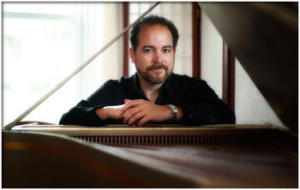
BACH EXPLORED, a series of three concerts surveying the roots of Bach’s musical language
With Violinist Dorian Komanoff Bandy & harpsicordist Paul Cienniwa presenting a recital-series
“Dark Visions”, probes the deepest reaches of human expression, from the musical ars moriendi to violinist depictions of grief and dispair
Second serie concert:
Wednesday & Thursday, January 28 & 29, 2015 @ 7:30pm
Jan 28: At New Bedford Art Museum/Artworks!, 608 Pleasant Street, New Bedford, MA
Jan 29: First Church in Boston, 66 Marlborough St., MA
$20 suggested donation
Contact: Paul Cienniwa, 617-466-9042 for more information
Thinly Disguised: New Release From Paul Cienniwa
Harpsichord Music For a Thin Place
So, what exactly is a ‘thin place’?
Mr. Cienniwa’s describes his vision; “A thin place is the threshold between the ordinary and the spiritual. The listener is brought here through the beautiful, stately elegance of the harpsichord’s most introspective repertoire.”
This definition provides insight into Mr. Cienniwa’s (Sin-‘e-wa) new recording and helps elevate the experience of this master work from musical to a more spiritual one, from terrestrial to celestial.
He continues, “This recording contains some of my very favorite slow, meditative harpsichord pieces. I was careful to select contemplative works over melancholy ones, favoring major keys over minor keys.” Bach, Byrd, Couperin, Forqueray, Froberger, Rameau, Sweelinck, and Bell.
From the selection of the repertoire, to its preparation, to the recording venue itself, Mr. Cienniwa adds that this project was made within a prayerful, meditative context. “It is my hope that the recording will touch and move listeners to crave other meditative experiences, while also encouraging them to seek out harpsichord recitals and recordings.”
Harpsichord Music for a Thin Place (Whaling City Sound #059), is, indeed, a visionary and meditative experience. With its focused concept and careful selections, the recording is consistently entrancing. Mr. Cienniwa’s harpsichord (William Dowd, 1966), the sole featured instrument, is pristinely played. Recorded in St. Francis of Assisi Parish, Swansea, MA in high-resolution digital, without audio compression, the recording itself is intimate and balanced, with rich sonority and expressive movements. There is little doubt of Cienniwa’s technical command of the instrument; what surprises is the depth of emotion, superbly captured, in these evocative performances.
Over the years, critics have showered Cienniwa with praise. His harpsichord playing has been called “expert” (Boston EDGE), and the Boston Musical Intelligencer wrote, “Not everyone can capture the Baroque French style as Cienniwa does.” For his recent recording of the Bach Viola da Gamba Sonatas (WCS046) with cellist Audrey Sabattier-Cienniwa, KBAQ radio (Phoenix, AZ) called his ability to accompany “spot-on…perfect.”
Throughout his career, he has demonstrated impressive versatility. For example, his recording with Grammy Award-winning uilleann piper Jerry O’Sullivan was called “drop-dead gorgeous” and named one of the top ten Irish traditional albums of 2010 by The Irish Echo.
Mr. Cienniwa began his piano study at the age of six, and migrated to harpsichord at the age of 19. Following undergraduate studies with harpsichordist Roger Goodman at DePaul University, he became a student of Richard Rephann and was awarded a Doctor of Musical Arts degree from Yale in 2003. From 2003 to 2010, he led Newport Baroque Orchestra (later Newport Baroque) in works from Arne to Zelenka, including performances of Bach cantatas and Purcell’s Dido & Aeneas and joined in collaborations with the Providence Singers, the Tufts Chamber Choir and Providence College. With grants from Target, the Rhode Island State Council on the Arts, the Rhode Island Council for the Humanities, the Apple Pickers Foundation and private donors, Newport Baroque Orchestra presented eight successful concert seasons of baroque music on period instruments. He now serves as organist, conductor, and music director at First Church in Boston, heard on weekly by WERS (88.9 FM, Boston).
distributed by: Allegro Media Group
Track List:
1 Premier Prélude 1:36 F. Couperin
2 Passacaille, C Major 6:43 L. Couperin
3 La Sylva 6:05 Forqueray
4 Quatriéme Prélude 2:04 F. Couperin
5 Andante, BWV 964 4:14 Bach
6 Cinquième Prélude 3:09 F. Couperin
7 Allemande (1726) 7:17 Rameau
8 Sarabande, Op. 97 2:46 Bell
9 O lux beata trinitas 4:03 Sweelinck
10 Ave verum corpus 3:27 Byrd
11 Chaconne ou Passacaille, g minor 3:47 L. Couperin
12 Fantasia 10, BWV 797 2:28 Bach
13 La du Vaucel 5:17 Forqueray
14 Second Prélude 1:53 F. Couperin
15 Allemande, D Major (1656) 4:09 Froberger
16 Les Soupirs 6:58 Rameau
One Thing About This Album:
A thin place is the threshold between the ordinary and the spiritual. The listener is brought here through the beautiful stately elegance of the harpsichord‚s most introspective repertoire. This recording contains slow, meditative harpsichord pieces, contemplative works over melancholy ones, favoring major keys over minor keys. From the selection of repertoire to its preparation to the recording venue itself, this recording was made within a prayerful, meditative context.
Key Promotion Markets:
Label Hometown: New Bedford; Artist Hometown: Niles; Also: Fall River, Boston, Phoenix, Chicago, Newport, Evanston, New Haven, NYC, Portland
Also Available: Whaling City Sound, WCS046, Audrey & Paul Cienniwa, Johann Sebastian Bach / Sonatas for Viola da Gamba
Press Quotes: …Cienniwa’s violoncello piccolo has a rich, dark-chocolate sonority well suited to expressive slow movements such as rapt andantes of BWV1027 and 1028…uncomplicated, instinctive…with a sure technical command, sound stylistic sense and remarkable musical rapport. They play the jubilant concertante-like second movement of BWV1027 and the spirited opening vivace of BWV1029 with vivid characterization, exhilarating spontaneity and all the requisite verve and drive, and their reading of the central Adagio of BWV1029 is poignant and profoundly expressive. Their inspired inclusion, as makeweights, of aria arrangements from two of Bach’s cantatas sets this disc apart from most of its competitors. The recording is full and resonant… The Strad


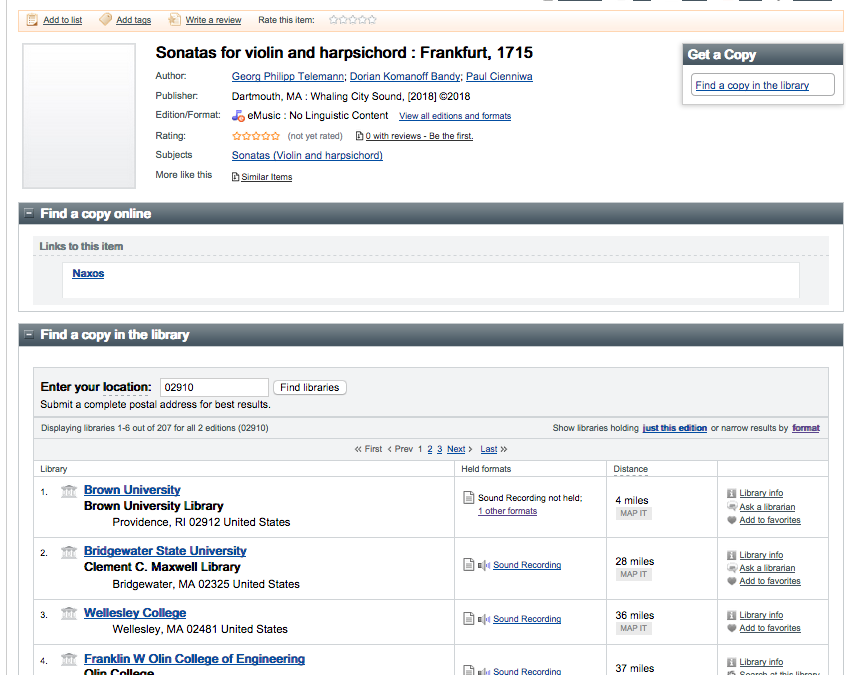
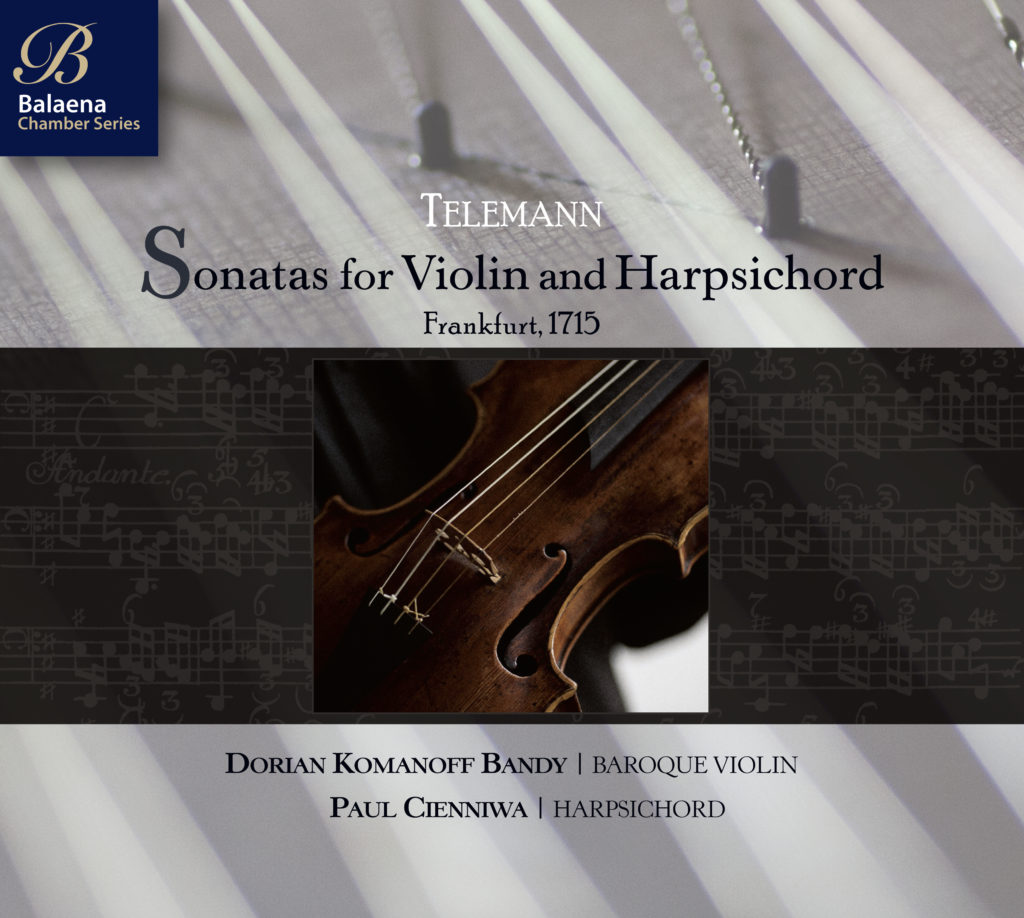
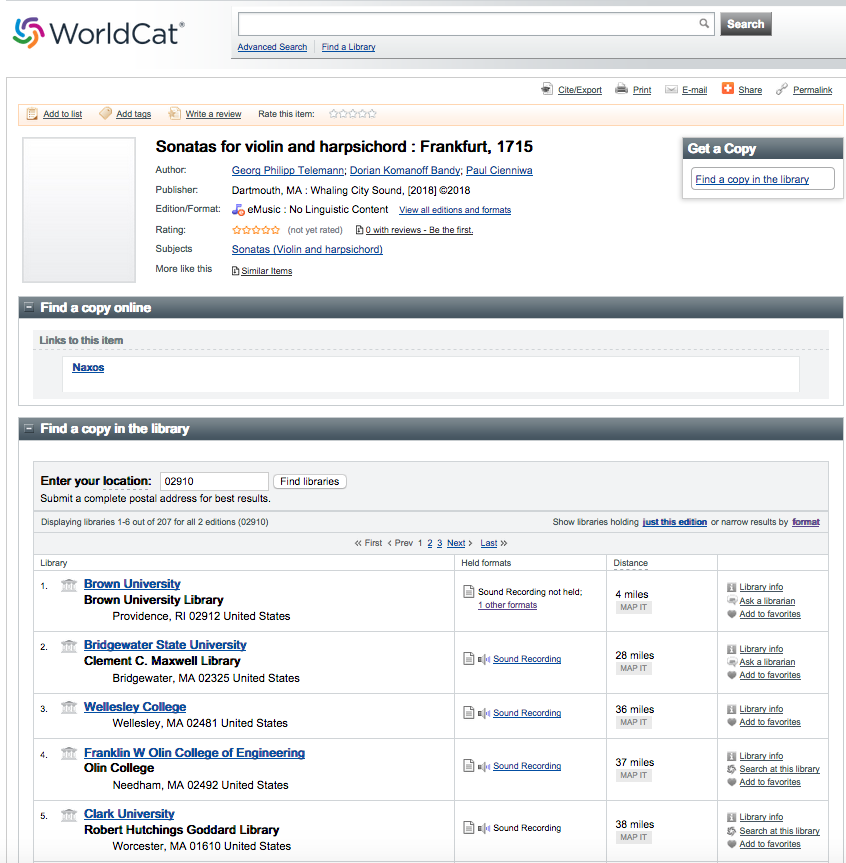

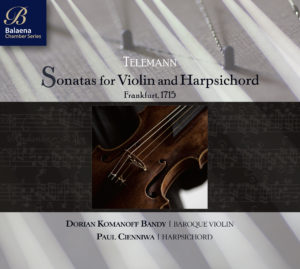
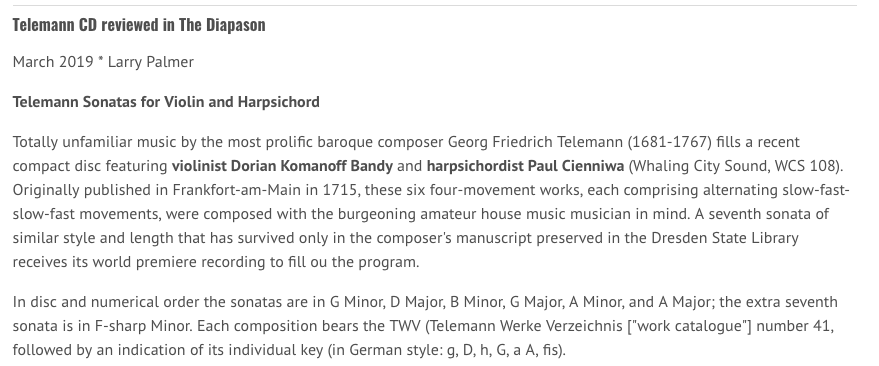






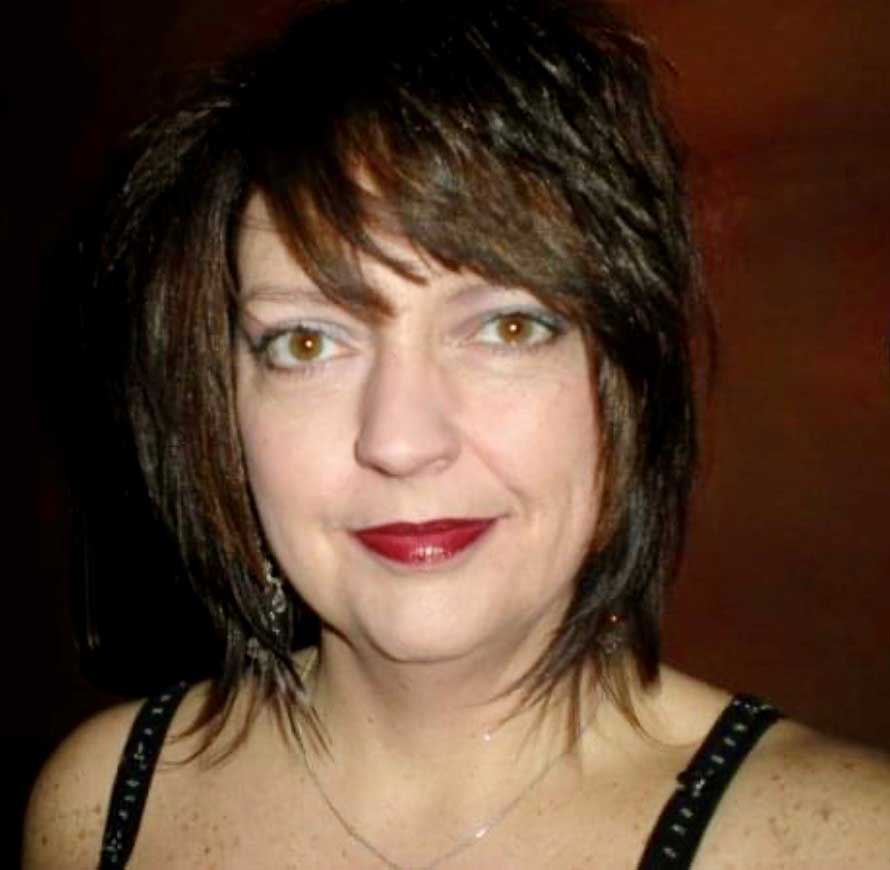 Music industry consultant and publicist Ginny Shea has garnered international exposure for her clients through radio and video promotion, print media, and her vast industry network.
Music industry consultant and publicist Ginny Shea has garnered international exposure for her clients through radio and video promotion, print media, and her vast industry network.